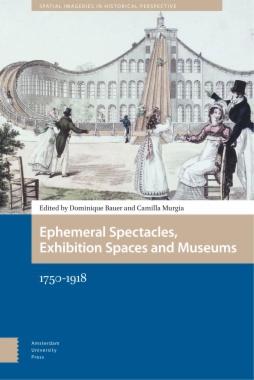This book examines ephemeral exhibitions from 1750 to 1918. In an era of acceleration and elusiveness, these transient spaces functioned as microcosms in which reality was shown, simulated, staged, imagined, experienced and known. They therefore had a dimension of spectacle to them, as the volume demonstrates. Against this backdrop, the different chapters deal with a plethora of spaces and spatial installations: the Wunderkammer, the spectacle garden, cosmoramas and panoramas, the literary space, the temporary museum, and the alternative exhibition space.
- Cover
- Table of Contents
- Introduction: Staging the Temporary: The Fragile Character of Space
- I: The Department Store
- 1. “One Need Be Neither a Shopper Nor a Purchaser to Enjoy:” Ephemeral Exhibitions at Tiffany & Co., 1870–1905
- Amy McHugh and Cristina Vignone
- 2. Enclosed Exhibitions: Claustrophobia, Balloons, and the Department Store in Zola’s Au Bonheur des Dames
- II: Spectacles
- 3. Jardins-Spectacles: Spaces and Traces of Embodiment
- 4. Parading the Temporary: Cosmoramas, Panoramas, and Spectacles in Early Nineteenth-Century Paris
- 5. Portable Museums: Imaging and Staging the “Northern Gothic Art Tour” – Ephemera and Alterity
- III: At the Intersection of Literature and the Built Environment
- 6. The Elusiveness of History and the Ephemerality of Display in Nineteenth-Century France and Belgium: At the Intersection of the Built Environment and the Spatial Image in Literature
- 7. The “Phantasmatic” Chinatown in Helen Hunt Jackson’s “The Chinese Empire” and Mark Twain’s Roughing It
- IV: The Museum and Alternative Exhibition Spaces
- 8. “Show Meets Science:” How Hagenbeck’s “Human Zoos” Inspired Ethnographic Science and Its Museum Presentation
- Stefanie Jovanovic-Kruspel
- 9. The Last Wunderkammer: Curiosities in Private Collections between the Nineteenth and Twentieth Centuries
- 10. The Impact of Alternative Exhibition Spaces on European Modern Art before World War I
- Nirmalie Alexandra Mulloli
- Index

